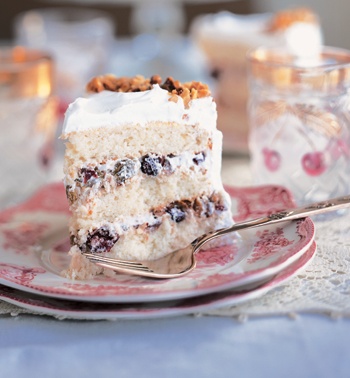Holidays at my maternal grandparents’ house almost always included a many-layered Lord Baltimore Cake served with Grandma’s homemade ambrosia. She’d spend all day in the kitchen to make the cakes, filling and ambrosia, including sectioning the oranges and grating the coconut by hand. Old-fashioned Southern cakes are a lot of trouble, but well worth it when the oohs and aahs come from your guests.
Nancie McDermott has captured those oohs and aahs on paper in her new book, Southern Cakes (Chronicle Books, 2007). It’s got all those old favorites—Lane Cake, Orange Slice Cake, Caramel Cake, Coconut Cake, Red Velvet Cake—and many more I can’t wait to try. Here, we’ve included a recipe from the book for Lady Baltimore Cake, which is akin to Lord Baltimore, of course, but with a fluffy white icing. McDermott writes, “My cousin Libbie Hall shared this family recipe for the queen of Southern cake extravaganzas, Lady Baltimore. Gorgeous and delicious, this cake is reason enough for you to indulge in a pedestal cake stand if you don’t have one already.”
Lady Baltimore Cake
Filling
1/2 cup golden or dark raisins
1/2 cup finely chopped dried figs, apricots, cranberries or dates
1/2 cup finely chopped pecans or walnuts
2 tablespoons brandy, sherry, orange juice or grape juice
Royal Three-Layer White Cake
2 cups sifted all-purpose flour
2 teaspoons baking powder
1/2 teaspoon salt
1 teaspoon vanilla extract
1 cup milk
1 1/2 cups sugar
1/2 cup (1 stick) butter or shortening, softened
4 egg whites
Icing
1 cup sugar
2 egg whites
1/4 cup light cor syrup
1/4 teaspoon salt
1/4 teaspoon cream of tartar
1 teaspoon vanilla extract
To make the filling, in a small bowl, combine the raisins, figs and pecans, and toss to mix well. Add the brandy or juice and toss to mix well. Set aside for 1 hour, or up to 1 day.
To make the cake, heat the oven to 350 degrees. Grease three 8-inch or 9-inch round cake pans, line each one with a circle of waxed paper or parchment, and flour the pans. In a medium bowl, combine the flour, baking powder and salt, and stir with a fork to mix well. Add the vanilla to the milk and set both mixtures aside.
In another medium bowl, beat the egg whites with a mixer at low speed until foamy, and then beat at medium-high speed until they become shiny, thick and stiff, but not dry.
In a large bowl, cream the sugar and butter with a mixer at high speed until light and fluffy, stopping to scrape down the sides of the bowl now and then. Reduce the mixer’s speed to low, and carefully pour in the milk and the vanilla, beating only until blended.
Add the flour mixture to the batter all at once, and beat at low speed only until the flour disappears. Add half the egg whites, folding gently with a rubber spatula or a large spoon until they are mixed well into the batter. Fold in the remaining egg whites gently, and then quickly divide the batter among the three cake pans.
Bake at 350 degrees for 25 minutes, or until the cakes are golden, spring back when touched gently in the center, and begin to pull away from the sides of the pans.
Let the cakes cool in the pans for 5 minutes on wire racks or folded kitchen towels. Then turn out the cakes onto wire racks or plates, carefully remove the paper from the bottoms, and then turn the cakes top side up to cool completely.
To make the icing, bring about 3 inches of water to a boil in a medium saucepan or in the bottom of a double boiler. Meanwhile, combine the sugar, egg whites, corn syrup, salt and cream of tartar in a large, heat-proof bowl that will fit snugly over the saucepan, or in the top of the double boiler. Beat for 1 minute with a mixer at low speed, until the egg white mixture is foamy and well combined.
Place the mixing bowl or the double boiler top over the pan of boiling water, and adjust the heat to maintain a gentle boil. Using a hand-held electric mixer, beat the sugar-egg white mixture at high speed for 7 to 14 minutes, until it swells into a voluptuous cloud of icing that holds firm curly peaks when the beaters are lifted. Remove from the heat, add the vanilla, and beat for 2 minutes more, scraping down the bowl once or twice.
To complete the filling, scoop about 1 1/2 cups of the icing into a medium bowl, and stir in the dried fruits and nuts, juice and all. Mix well and set aside.
To complete the cake, place one layer on a serving plate, top side down, and scoop half the filling onto the cake. Spread the filling over the cake layer, making it a bit thicker around the edges. Cover with a second layer, top side down, and spread the remaining filling the same way.
Place the third cake layer on the second one, top side up, and then ice the entire cake with the remaining icing, spreading it evenly over the sides and then the top. Use a table knife to swirl the icing into beautiful peaks and curls. Serves 6–8.
Nancie McDermott, Southern Cakes (Chronicle Books, 2007)
Brown Sugar Pound Cake
3 cups all-purpose flour
1/2 teaspoon baking powder
1/4 teaspoon salt
1 teaspoon vanilla extract
1 cup milk
One 1-pound box (about 2 3/4 cups) dark brown sugar
1/2 cup sugar
1 1/2 cups (3 sticks) butter, softened
5 eggs
Heat the oven to 325 degrees. Grease and flour a 10-inch tube pan, or two 9-by-5-inch loaf pans.
Combine the flour, baking powder and salt in a medium bowl and stir with a fork to mix well. Stir the vanilla into the milk and set aside.
In a large bowl, beat the butter with a mixer at high speed until light and fluffy. Add the brown sugar in 3 batches, and then add all of the white sugar, beating well after each addition.
Add the eggs, one by one, beating well after each addition. Add half the flour, and then half the milk, beating at low speed only until the flour or milk disappears into the batter. Add in the rest of the flour, and then the remaining milk, in the same way.
Quickly scrape the batter into the prepared pan, and bake at 325 degrees for 1 hour and 10 minutes (55 to 60 minutes for loaf pans), or until the cake is nicely browned at the edges, springs back when touched lightly at the center, and a wooden skewer inserted in the center comes out clean.
Cool the cake in the pan on a wire rack or a folded kitchen towel for 20 to 30 minutes. Loosen the cake from the pan with a table knife, and turn it out onto a wire rack or a plate to cool completely, topside up.
Serves 6 to 8.
Quick Caramel Glaze
1/2 cup (1 stick) butter
1 cup light brown sugar
1/2 cup evaporated milk
4 cups sifted confectioners’ sugar
1 teaspoon vanilla
Combine the butter and the sugar in a medium saucepan. Stir over medium heat until the butter melts and blends with the sugar into a smooth sauce, 2 to 3 minutes. Add the milk, and let the icing come to a gentle boil. Stir well, remove from the heat, and add the sifted confectioners’ sugar. Beat well with a mixer, whisk or spoon for 1 or 2 minutes, until the icing thickens and loses a little of its shine. Use at once. If the glaze hardens, stir in 1 or 2 spoonfuls of evaporated milk to soften it.
Makes enough for one 3-layer cake, one tube or Bundt cake, or one 13-by-9-inch cake.
Nancie McDermott, Southern Cakes (Chronicle Books, 2007)


